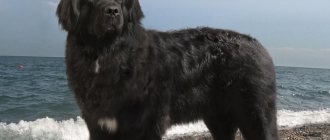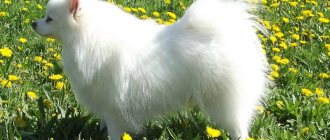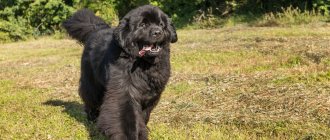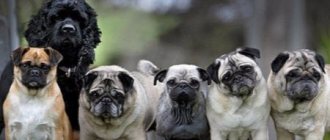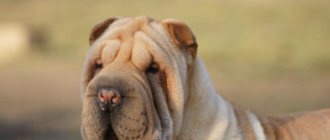The very name of the breed comes from the birthplace of these giants. In the distant past, on the small island of Newfoundland, there was a settlement of fishermen. When they approached the shore, the shaggy dogs, taking the rope in their mouths, swam to moor the boat. For maneuverability in the water, they had webbed feet and a very strong tail; this is the only dog with such a feature that has survived to this day.
Loyalty, kindness, intelligence, strength and power have made the breed quite popular throughout Europe. The Newfoundland was used as a carrier in agriculture, a postman, and a rescuer of drowning people.
But, thanks to these very qualities, they found themselves on the verge of extinction. At the end of the 18th and beginning of the 19th centuries, a law was passed requiring a large tax to be paid on dogs, and since it was necessary to pay twice as much for bitches, the puppies had to be killed. Then selection was completely banned.
But fortunately in England there were nurseries and the breed was saved. Miraculously, she survived, having gone through many trials, and became known and loved throughout the world.
Appearance Features
- Large head with a convex skull;
- Large nostrils and nose, the muzzle is square-shaped with short shiny hair;
- Small jowls, but the skin is without folds;
- The eye shape is average, the color depends on the color. Black individuals are dark brown, while brown individuals have lighter tones;
- The ears are square-shaped, medium in size, fitting tightly to the head;
- The shape of the abdomen is round with straight lines;
- The paws are round in shape, strong, with membranes between the toes. They are located evenly to each other, the elbow bones are tightly pressed to the body;
- The hind legs are powerful, slightly bent at the knee, there are dewclaws that need to be removed. Wide pelvis;
- The tail is wide, with strong muscles; in the water it serves as a guiding lever. Lowered down and the tassel slightly raised.
Feeding
The diet needs to be selected from the first days of the puppy’s life in the house. The main thing is to fight excess weight gain. To regularly monitor your pet's weight, you should buy floor scales. By weighing your puppy daily, you can adjust the components of the food to eliminate those that contribute to sudden weight gain.
Experts recommend feeding diver puppies with special food for giant dog breeds. Such industrial feeds include the required amount of vitamins, macro and microelements that growing Newfoundlands need to strengthen skeletal bones and build muscle. Also, the consumption of such food by puppies eliminates diseases such as deformation of the limbs under the weight of the body weight.
It is more advisable to feed adult individuals with natural food. In this case, food for the animals is cooked every day. The food must contain meat (about 40% of the total food). Cereal crops are selected based on the individual characteristics of the animal. If the dog is prone to obesity, then only rice is added to the food. If a dog’s metabolism is too fast, then buckwheat and barley groats (in equal parts) are added to his food. The daily diet must include vegetables - boiled and raw.
Important! These dogs should not be given bones. The powerful jaws of Newfoundlands grind them into small fragments. These fragments, entering the dog’s esophagus, injure it, which is very dangerous for the dogs’ health.
Training
The character of the Newfoundland is calm and obedient; by the age of 2-3 months, the baby can follow a couple of simple commands.
Considering that this breed loves water, training near a pond is mandatory. Just don’t force him there, you need to get him interested. When a child finds himself in the water element, his instinct to save is activated, no matter whether the person is drowning or standing in the water. The owner comes across first.
The dog always tries to please; in case of failure, you need to be patient, not punish your pet, just tell him about it.
You need to start with the simplest:
- Walk with or without a leash nearby;
- Sit;
- Lie;
- Give me a paw.
History of the breed
The origin story of this amazing dog is lost in legend. It is believed that its homeland is the Canadian province and especially the island with the same name.
In ancient times, the paths of the Indians with their faithful four-legged friends and the Vikings with their dog companions crossed on the island. As a result, a mixture of breeds was formed, the descendants of which adapted to the cold climate of the territory of residence.
The island was attractive to fishermen and travelers, people of different nationalities came there, and eventually the British conquered it.
It is believed that it was they who brought another breed - the Tibetan mastiff, which mixed with the local canine inhabitants. And then Scottish, French and Norwegian dogs were added to this cocktail of genes.
All of them also formed a mixture of local tetrapods and took from them the ability to survive in cold and wet climates. This is how the Newfoundland dog breed appeared.
In the 18th century, sailors discovered dogs that could swim perfectly. I was amazed by their enormous size and their calmness, ability to swim and love for people. Dogs began to be transported all over the world.
I admired their ability to save drowning people and survive in cold and salty water. There are many stories of divers saving drowning people.
And since the 19th century, different countries began to improve the breed and describe its traits, thanks to which in modern times it became possible to explore the intricate genealogy of the Newfoundland.
Care
The most pleasant procedure for a dog is daily brushing. Beautiful long hair and thick undercoat have the property of annual self-renewal. To do this, it is important to choose the right tool.
If this moment is neglected, then it will be almost impossible to comb out balls of tangled old fur. In this case, it is necessary to trim them, which will not have a very good effect on the appearance.
Trimming and grooming are not allowed if the dog is being taken to a show, but it can make grooming much easier. You can wash with shampoos as needed so as not to remove the protective layer.
Brushing your teeth is also considered an integral part of care. Trimming nails. Checking and cleaning ears and eyes.
Dog character
The Newfoundland is a friendly and patient dog. They always remain faithful to a person, get along well with children, and are also considered excellent helpers. All owners leave only positive reviews about the character of the Newfoundland.
During the selection process they became completely non-aggressive. A Newfoundland will never bite a person; at most, it can knock someone down for protection.
They are also friendly towards other animals, so they definitely will not become instigators of conflicts in the house.
Nutrition
This breed is prone to obesity, so you need to carefully select your diet.
The first 6 months, food consists of animal fats and protein, 7 times a day. After this age, the number of calories and meals decreases to 4 times a day
The food must be balanced; you can combine the following products:
- All vegetables and fruits in any form except grapes;
- Only sour milk;
- Buckwheat, rice and oatmeal;
- All types of meat except pork;
- Quail eggs;
- Processed sea fish;
- Some vegetable oils.
A dog that has reached the age of 1 year can be transferred to a single meal in a volume of 4-5 liters of total volume.
Training
The need to educate dogs of this breed from childhood is well understood by their owners. When the dog grows to its natural size, not everyone can move it from its place or direct it in the right direction. Therefore, the dog must know and follow all basic commands.
Training puppies and older Newfoundlands is quite simple, and even a novice dog breeder will be able to cope with training his first pet of this breed. Animals have excellent memory, as well as a high level of intelligence, and they always try to please their owner, so they are easy to train.
But you should remember about the main character traits of such a pet - their innate slowness and phlegmatism, therefore, when giving a command, you should not expect that the Newfoundland will carry it out at the same second - this dog needs time to think. You cannot scold your pet for such slowness!
It is best to train Newfoundlands in special areas under the guidance of an experienced instructor who will tell you how to properly train this large pet.
With proper training, by the age of one year, a grown-up diver will know all the necessary commands.
Diseases
Over the course of 10 years of life, even with good care, the following diseases may occur along the way:
- Congenital hip dysplasia cannot be cured;
- Diseases of the heart;
- Flatulence;
- Inverted or rolled-in eyelid;
- Hepatitis;
- Coccidiosis;
- Hormonal imbalance in the thyroid gland;
- Volvulus.
Puberty occurs before 12 months, but the first mating is possible only after reaching 20 months.
Where to buy puppies
You can find representatives of this breed in any city: just study advertisements for purchase or search at the poultry market.
But in this case, there is a risk of purchasing a sick or problematic puppy. In this regard, the question arises: where is the most reliable and safe place to buy a Newfoundland dog?
The answer is simple: in a nursery or from a professional breeder. Only then can you be sure that the puppy has a decent pedigree and all the necessary vaccinations. The price of a Newfoundland usually varies from 20 to 50 thousand rubles.
Newfoundland photo
Price
The cost of puppies of this breed varies depending on their purebred, availability of all necessary documents and the opportunity to participate in future exhibitions (or raise breeding offspring).
Depending on the above reasons, the price of puppies ranges from $350 to $2000.
The Newfoundland is a dog that can be an excellent watchdog, rescuer, nanny and companion. If you follow the rules for the care, training and feeding of these animals, one of the best and smartest dogs in the world will live in your home.
Mating
- Newfoundlands are very large dogs, so there should be plenty of space for them to mate . Dogs must be brought together in the dog's territory. The first time should be carried out under the guidance of a specialist.
- Puberty comes to dogs at the age of 8-10 months, but they can only be bred at 20, when the bitch has her 3rd heat , otherwise she will not be able to bear healthy offspring. Signs that a girl is ready: light discharge, a swollen loop, playful behavior.
- Both dogs need to be examined for pathologies and diseases. It is also necessary to remove worms and external parasites two weeks before mating.
- Sexual intercourse can last 10-15 minutes, and the lock 20-30. The girl must be supported under her stomach and not allowed to sit down. The dog is sent into the loop. In the castle, the dogs are restrained, but in such a way as not to injure the genitals. Mating is repeated after 2 days.
Health
Newfoundlands are susceptible to certain diseases.
- Addison's disease
- Cataract
- Cherry eye, known as third eyelid
- Subvascular aortic stenosis
- Epilepsy
- Dysplasia hip dysplasia
- Elbow dysplasia
- Hypothyroidism is a disorder of the thyroid gland
- Cystinuria is an inherited disease
- Cancer
- Volvulus of the stomach
Preventative measures to protect your Newfoundland puppy
- To keep your Newfoundland puppy completely safe, you first need to minimize his contact with unfamiliar dogs, especially strays. Therefore, you should not let your dog off the leash, as in this case it will become impossible to control its behavior and communication with other dogs. Since a dog can easily become infected with distemper from simply touching the nose of a sick animal. This disease can be transmitted to a dog through sniffing. Your dog can become infected with trichophytosis from contact with the lichen-affected fur of a sick dog. Naturally, it is impossible to completely exclude a dog’s communication with other dogs, since it must be socialized. Therefore, try to find friends with dog lovers who look after their animals. By adhering to this rule, you can eliminate the risk of pathogen transmission by 80%.
- You should walk your dog in places where there are no landfills. Since garbage very often attracts rodents, which in turn are very often carriers of various infections. Gray rats are especially dangerous because they carry such a serious disease as leptospirosis.
- You should not allow your dog to sniff other people's feces, as they are a source of worms.
- Monitor your Newfoundland's health. Pay attention to even the most minor changes in his behavior. For example, your dog may appear lethargic, lose his appetite, or have a dry nose. Or you may notice that the dog begins to shed, and this has nothing to do with seasonal shedding. If hair loss becomes excessive, this is the first symptom indicating health problems in your pet. And only you can help him. Therefore, it is important to take the dog to the veterinary clinic in time, where the disease can be overcome for sure. In no case should you ignore the symptoms, since advanced infections are much more difficult to treat, and sometimes even impossible. If you start treating your dog, the disease can lead to his death or he will develop serious complications that will affect his hearing, vision, limbs and much more.
Characteristic
Newfoundland is a very popular breed, and these dogs have received worldwide recognition a long time ago. So, in Russia the breed was known even before the revolution. And in the Soviet Union, these large dogs were no less loved than German shepherds, and were better known under the name “diver”. This name aptly characterizes the main feature of animals - an extraordinary, innate love for water, which is due to their origin.
FCI breed standard: No. 50
Newfoundland dogs belong to group 2 - Swiss Shepherds, Pinschers, Schnauzers, Molossers. Section 2.2: mountain dog and molosser type.
Newfoundlands are intended for use as sled dogs, carrying loads of significant weight, and, of course, as water dogs.
General description of the breed
Newfoundlands give the impression of being strong, powerful, even massive dogs, harmoniously built, with thick and long hair.
They have a large, heavy skull, and in males it is more massive than in females. The forehead is quite high and convex. The muzzle is square, with a large nose and soft lips, but without any folds. The fur on the face is short and soft. The ears are hanging, rounded, and short in length. The eyes are small and dark, widely and rather deeply set. Correct scissor or level bite.
Powerful and muscular, but at the same time a long neck without dewlap, which gives nobility to the posture and carriage of the head. The body is strong, massive, with a wide back, massive and strong loin and croup. The chest is wide and voluminous, the abdominal line is straight, not retracted.
The limbs are strong, even, with good but not excessive muscular definition on the shoulders and hips. Dense, collected paws.
Height, weight of an adult dog
Divers are very large dogs, and despite their height, they have strong bones and well-developed muscles. Males, with a height at the withers of 71 cm (according to the standard), should weigh about 68 kg. Bitches, having a height of 66 cm, should reach a weight of 54 kg.
Color
Wool, its structure and properties are one of the main features of dogs of this breed. Their coat is thick and long, with silky and straight guard hairs and a thick undercoat. Wool has water-repellent properties. During the cold season, the undercoat becomes thicker. The hair on the face and ears is short. There are thick feathers on the hind legs and tail.
Newfoundlands have three color varieties:
- Black is the most traditional and common. In illustrations showing animals of this breed, they are depicted in an even, black, very recognizable color. The color is rich and thick, uniform throughout the body. Minor white areas on the chest, paws, and the end of the tail are acceptable.
- White and black is a color that has historical significance for the breed. The most common form of color is a large black spot with a blaze on the head, a saddle on the back, a spot on the croup, and a mark on the tail. Smaller specks should be absent or minimal.
- Brown - includes a uniform color from chocolate to bronze. There may be small white markings on the toes or the tip of the tail and chest.
Puppy weight by month
Large dogs like the Newfoundland grow quickly. Their weight at birth depends on the size of the litter: the more puppies are born, the correspondingly smaller each newborn will be. However, regardless of size and birth weight, these babies become strong, big dogs if they are properly cared for and fed. It's just that a small puppy will grow faster to catch up with its larger counterparts.
- 30 days after birth, the weight of the Newfoundland baby will be about 4-5 kg.
- In the second month, this figure will more than double – 10-12 kg.
- By the third month the weight will be 16-18 kg.
- At 4 months the puppy already reaches 3-25 kg.
- By five months, a little Newf can grow up to 30 kg.
- At six months the average weight is 32-36 kg.
- A seven-month-old puppy weighs up to 38 kg.
- At eight months, the weight of the Newf reaches, on average, 40 kg.
- At 9 months - about 42 kg.
Then the dog gains 3-5 kg per month, reaching an average of 50-54 kg by the year, the weight of an adult dog. This is the period of main growth, then the dog can build muscle mass and slightly increase in size.
average life expectancy
On average, Newfies live 8-10 years. This is a normal figure for such large dogs. Note that such statistics include calculations that also take into account the mortality of puppies. Therefore, based on research from the American Newfoundland magazine, we can say that most of these wonderful dogs, with good care, live up to 9.5 - 10 years.
Allergenicity
Despite all their “human” qualities and wonderful character, Newfoundlands are not suitable for people who are allergic to dogs. Their thick, double, waterproof fur sheds. In addition, some dogs may drool, which is also an allergen. Therefore, allergy sufferers who want to have a large and peace-loving dog should better turn their attention to the Great Dane.
